A Well-Developed Community-Based Marine Protected Area Proves Resilient to a Crown-of-Thorns Sea Star Outbreak
Location
Nimpal Channel Marine Conservation Area, Yap, Federated States of Micronesia
The challenge
Yap State is situated in the westernmost region of the Federated States of Micronesia (FSM). The main island of Yap State is located within the Indo-Pacific center of biodiversity. The island is approximately 100 square kilometers, with a densely vegetated and hilly landscape. It is home to 7400 residents spread over 10 municipalities; a relatively small population compared to the other states of Micronesia. The population and urban center are slowly growing, placing increasing pressure on the islands’ natural resources for subsistence and economic gain.
The Nimpal Channel is located off the central-western coast of Yap. Both Okaw and Kaday villages have their fishing grounds associated with the Nimpal Channel. The villages are within the municipality of Weloy, home to approximately 1000 residents. In 2005, a men’s village meeting was called to address the ongoing problem of overfishing in their channel, and they decided to seek help and information from outside their community. In 2006, a rapid ecological assessment (REA) was conducted across Yap Proper, including the Nimpal region, so that stakeholders could better understand the current status of their resources. The coral reef monitoring and assessment team for the REA process consisted of many knowledgeable fishermen from Okaw and Kaday villages, as well as regional scientists with local and global expertise. Following data collection and reporting efforts and realizing that Nimpal’s resources were not as well off as other places in Yap due to both natural causes and local fishing pressures, these two villages began discussing their desire to set aside part of their reefs as no-take fishing areas.
While the Nimpal Channel is very narrow (approximately 0.5 kilometers wide) and has only a limited mangrove stand associated with it, the two communities proposed to make it a Marine Conservation Area (MCA). Through the REA process, marine scientists recommended other areas for protection that were larger, deeper, and had more extensive connections with nearshore mangrove habitats known to nourish juvenile fish populations. To marine scientists, the area that Okaw and Kaday proposed to set aside was clearly influential for the locally owned marine resources yet smaller in size and harbored less biological diversity than other larger and more extensive channel systems nearby. In short, this was not the most ideal area to bolster fishery resources based upon ecological criteria alone. However, the timing was right, and the two communities strongly supported management in that area. Shortly after, in May 2008, Okaw and Kaday, in partnership, publicly declared the Nimpal Channel as a Marine Conservation Area with technical support from the Yap Community Action Program. Within 1-2 years, monitoring results began to document improved fishery resources in the conservation area. These positive results were an immediate testament to strong community support for management and dedicated local enforcement.
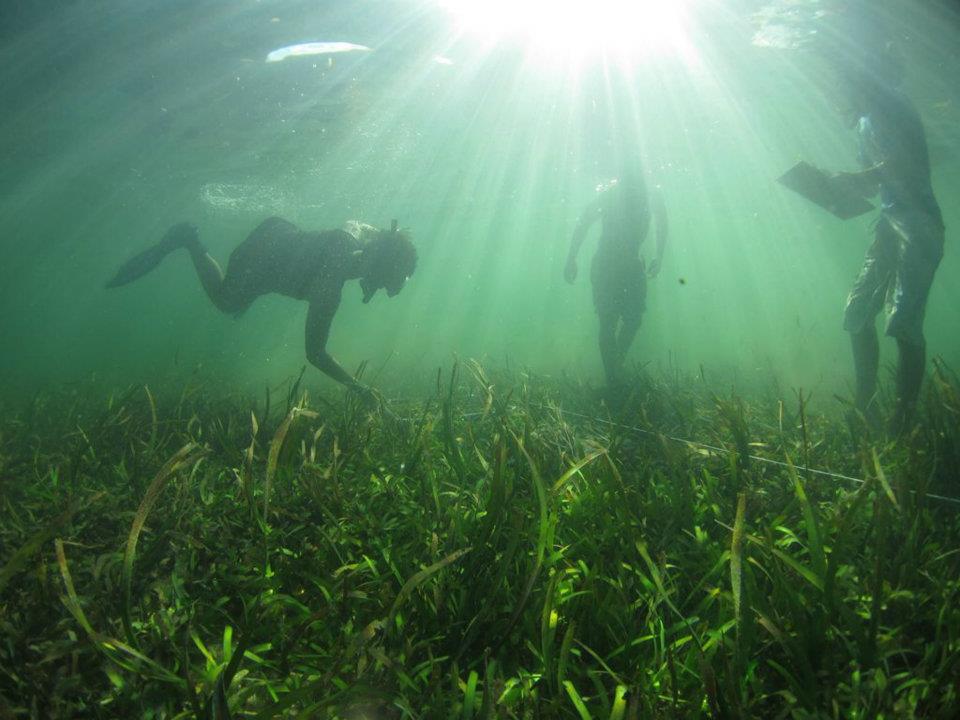
Monitoring seagrass beds. Photo © Nimpal Channel MCA
In late spring 2009, Acanthaster planci, commonly known as the crown-of-thorns sea star (COTS), began populating the coral reefs around Micronesia (from Pohnpei westward to Yap). A. planci is a carnivorous species of starfish that preferentially preys upon hard corals, including Acropora and Montipora species. COTS were first quantified in monitoring programs off the southwest coast of Yap, and anecdotal reports from fishermen and data suggested a northward migration up the west coast of the island.
This crown-of-thorns sea star outbreak in 2009 was not a new threat for Yap. COTS outbreaks have been described as natural, cyclical events. Some experts theorize that COTS outbreaks occur when the sea stars ‘sense’ oceanic conditions are most conducive for their larval offspring to successfully develop, and hence the initial outbreaks may be triggered by some form of nutrient enrichment in the surface waters near coral reefs. Following spawning from initial population outbreaks, it has also been hypothesized that larvae may get caught in ocean currents and somehow influence secondary starfish outbreaks downstream. In Yap, the single most significant COTS event was documented in the early 1970s, although there is local knowledge of smaller outbreaks over the years.
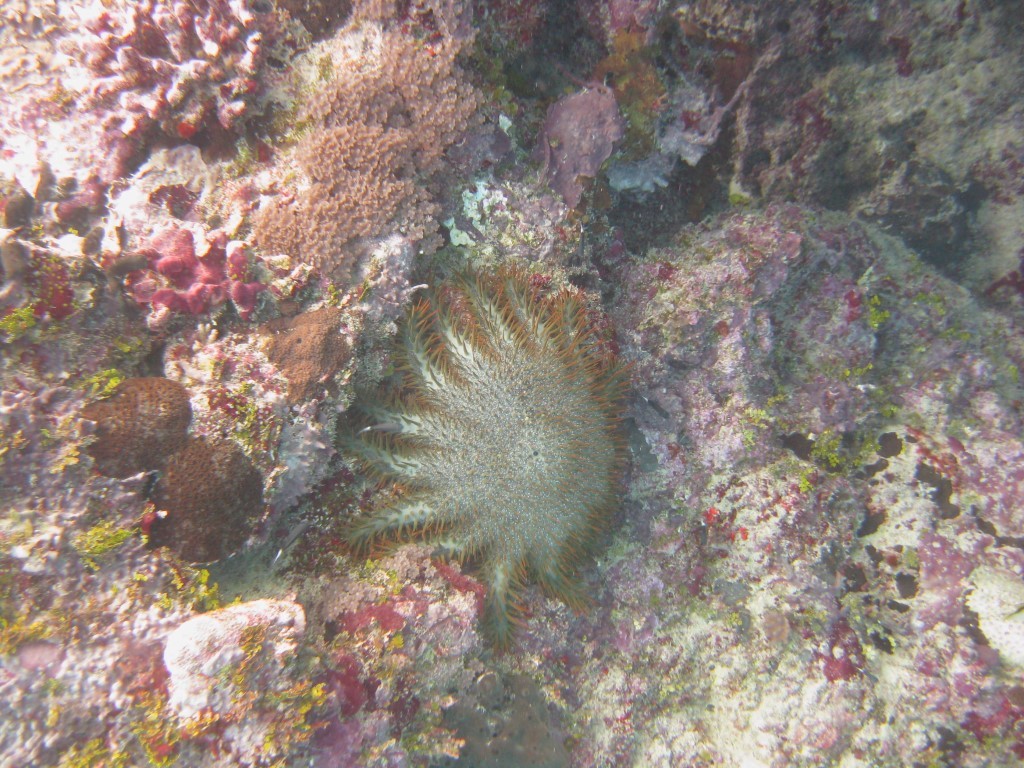
A crown-of-thorns starfish on a reef in Yap outside of Nimpal MCA. Photo © Peter Houk
Actions taken
During the 2009 COTS outbreak, there was no official attempt on Yap to remove the sea stars from the reefs, but fishermen noted their presence. The communities chose to adhere to the established no-take MCA policy and decided not to remove the crown-of-thorns sea stars in the Nimpal Channel MCA. To the local community, the sea stars are well known, but their lifecycles remain mysterious. Locals understand the origins of threats to the reefs like bleaching, sedimentation, and overfishing; but outbreaks of the crown-of-thorns sea stars suddenly occur without any obvious proximal cause. Subsequent COTS outbreaks have not been recorded, but a bleaching event in 2017-2018 damaged many corals around Yap. Researchers have collected data on the event and are analyzing it to determine if there are differences in how the bleaching event affected corals within Nimpal Channel MCA versus corals outside the MCA.
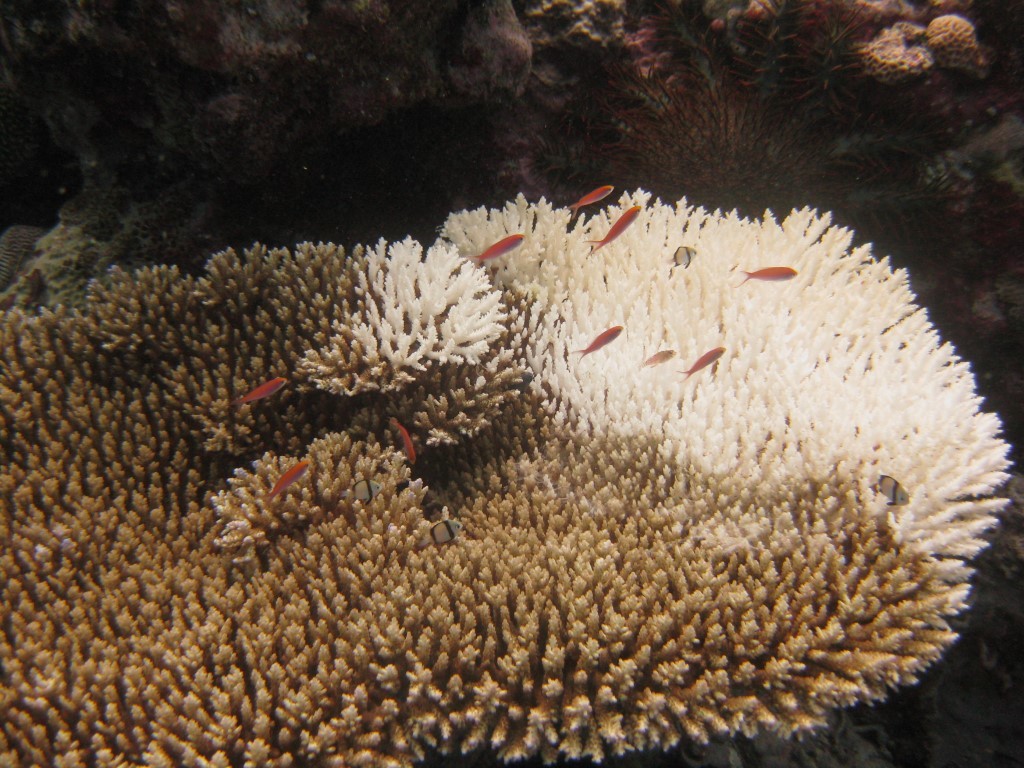
Acropora coral showing feeding scars from crown-of-thorns starfish on a reef outside of Nimpal MCA in Yap. Photo © Peter Houk
How successful has it been?
After the crown-of-thorns sea star outbreak in Yap, recovery of the coral reefs varied. A recent study revisited the sites where coral populations were monitored as part of the 2006 REA survey and found interesting results. Many reefs along the western coast of Yap showed an expected decline in coral colony sizes and diversity, but there was one exception: the Nimpal Channel MCA appeared to be more resilient to the disturbance event compared with sites to the north and south. Remarkably, no crown-of-thorns sea stars were found in the protected area during surveys shortly after the COTS event. In fact, monitoring of the area during the disturbance revealed an increase in coral colony sizes, no significant change in diversity within coral groups, and consistently high fish biomass. Reefs in the protected area showed high abundances of Porites species (the less desired coral for A. planci), but Acropora species also remained throughout the disturbance period. The area’s resistance to COTS is hypothesized to be due to an intact predator fish population and high coral diversity. Subsequent annual assessments show that the Nimpal Channel MCA remains one of the most successful MPAs in Micronesia and continues to hold fish biomass across most trophic guilds at two to three times higher than reference sites.
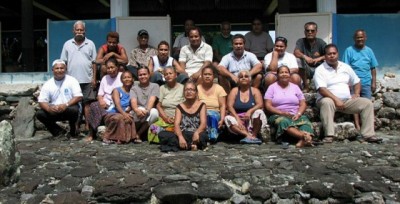
Community participants in a planning workshop. Photo © Nimpal Channel MCA
In contrast, formerly diverse reefs with extensive coral growth, such as off the southwestern tip of Yap, were heavily impacted by the COTS outbreak and reported little recovery as of 2013. Other coral reefs to the north of the Nimpal Channel MCA started to recover in 2012, but recovery has been a slow process and remains ongoing. These findings suggest that the establishment of the locally managed MCA may have benefitted the resilience of Nimpal’s reefs and might be supporting recovery along adjacent reefs.
While the Nimpal Channel MCA was initially established to aid fish stock recovery, it was later found to have added benefits of enhanced resistance to COTS. The success of the Nimpal Channel Marine Conservation Area in both enhancing fish populations and mitigating the damage done by the 2009 disturbance continues to be a very popular and productive discussion at regional management meetings across Micronesia. While other MPAs in Micronesia have had similar success, no other MPAs have had the same success for over a decade, making Nimpal the best example of success in the region. This case study highlights the importance of well-managed marine protected areas for weathering disturbance events.
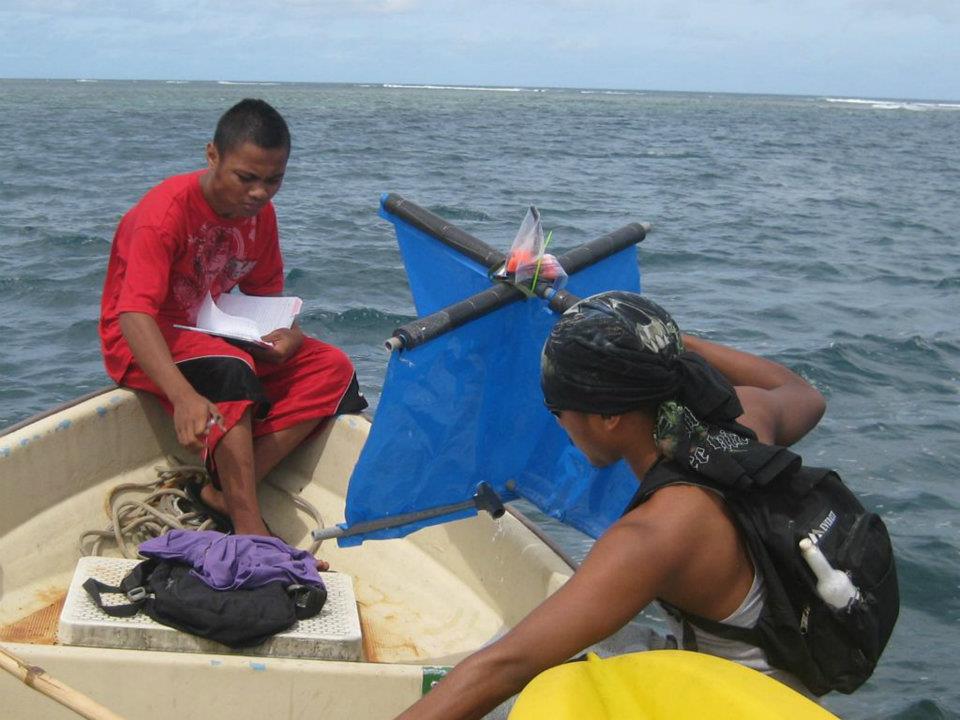
Installing monitoring equipment. Photo © Nimpal Channel MCA
Lessons learned and recommendations
People, rather than biology and science, are most important to think about when establishing a marine protected area. Without the community’s dedication to protecting their channel, the Nimpal Channel Marine Conservation Area would never have been established. Based on biological considerations and the small size of the managed area, scientists felt other areas were better suited to set aside as a protected area; it was only through the community’s will and support that their protected area was established. Science is used to drive management recommendations, but other factors might be more relevant for successful management.
The success of a marine protected area is dependent on community involvement and knowledge. The success of the Nimpal Channel MCA is due to community-based decisions based in traditional ecological knowledge and supported by scientific measures. Consequently, the Nimpal Channel MCA is one of the few functioning protected areas in Yap.
Quantitative monitoring is essential for responding to increased frequency and intensity of disturbances. Identify critical biological thresholds in your management area. Coral reef ecosystems are complex and can behave in a non-linear manner (for instance, the decline of a predator fish population might not reduce a reef’s resistance to a COTS outbreak until the predator fish population declines past a critical threshold). Part of this non-linear behavior is related to trophic interactions, such as interactions between predators and prey. Science has not fully explained trophic interactions and thresholds in coral reef systems. Disturbances are becoming more and more frequent; there might be a COTS outbreak one year and a bleaching event the next year. Because of the increasing frequency and severity of disturbance events, it is important to collect quantifiable data to understand rates of change. For example, monitoring fish biomass in your area can be a good starting point to understand how fish biomass is related to reef resilience. The relative level of biomass within different trophic levels may be related to the maintenance of coral reefs through time.
Funding summary and partners
Department of Environment, Climate Change & Emergency Management (DECEM) Federated States of Micronesia Ridge to Reef
Kaday Community and Cultural Development Organization
Pacific Marine Resources Institute
Yap Community Action Program
Marine Laboratory, University of Guam
Water and Environmental Resource Institute of the Western Pacific, University of Guam
Palau International Coral Reef Center (PICRC)
The Nature Conservancy Pacific Islands Program
Micronesian Conservation Trust
Seacology
Conservation International’s Pacific Islands Program
Pacific Development & Conservation Trust
OneReef Micronesia
Written by: Peter Houk, Marine Laboratory, University of Guam
Berna Gorong, Kaday Community and Cultural Development Organization
Eva Buthung, Yap Community Action Program, Marine Program
This case study was adapted from: Cullman, G. (ed.) 2014. Resilience Sourcebook: Case studies of social-ecological resilience in island systems. Center for Biodiversity and Conservation, American Museum of Natural History, New York, NY.

